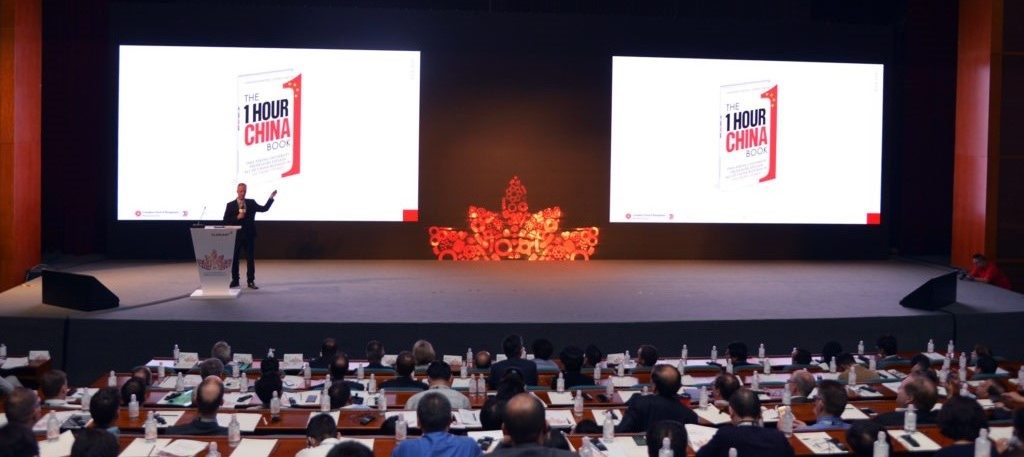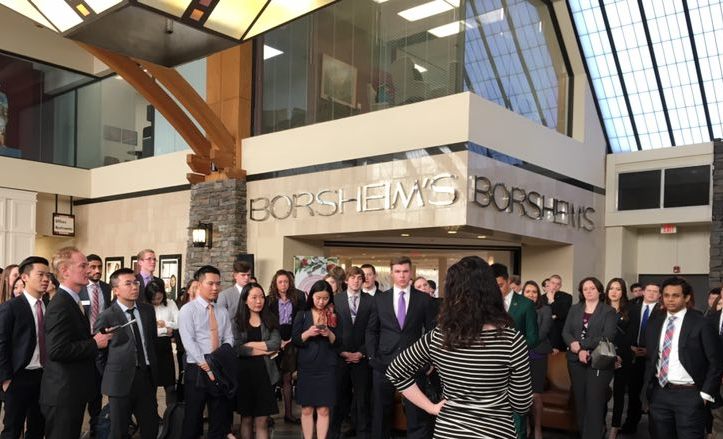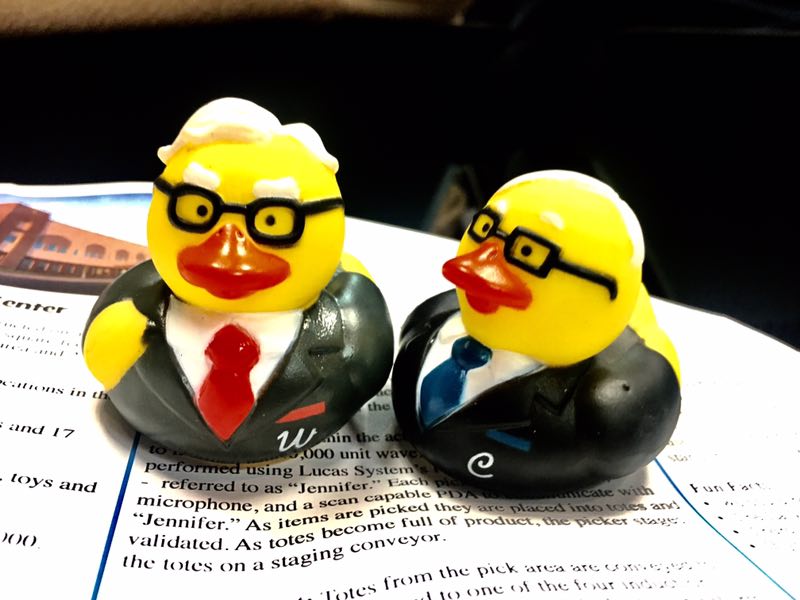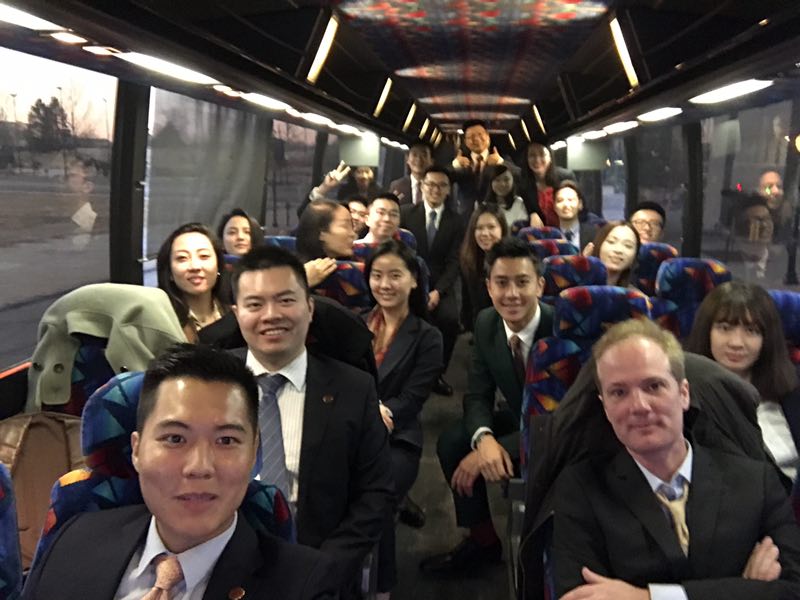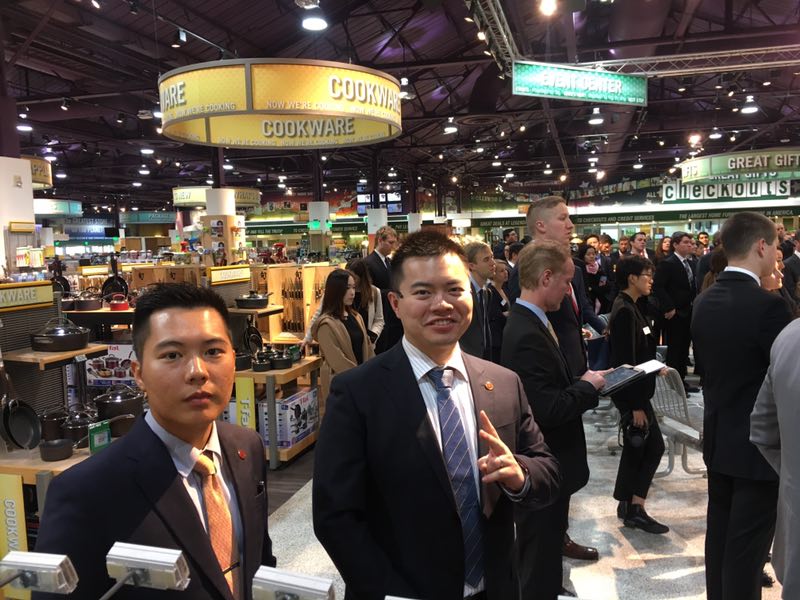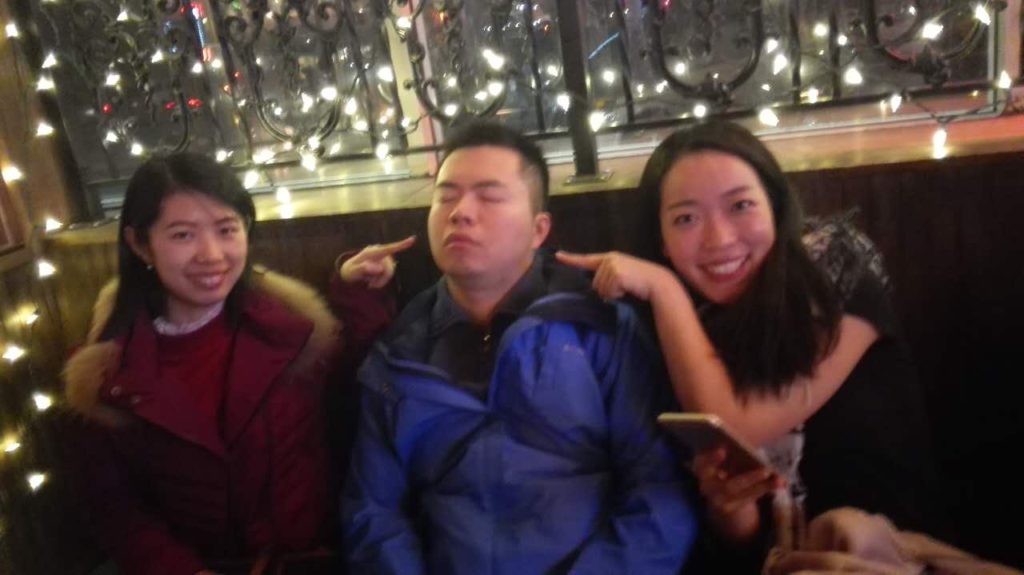In February 2017, I chaperoned 20 business students from Peking University to meet Warren Buffett in Omaha. It turned out to be a once-in-a-lifetime trip, an investment pilgrimage of sorts.
In 4 articles, I document what happened and what we learned. I have included a lot of detail, especially on the Berkshire companies we visited and on Warren’s comments. So this is a pretty long account. This is Part 4 (Part 1 is here, Part 2 is here, Part 3 is here)
Part 4: Visits to Borsheims Jewelry and Oriental Trading Company – And Leaving Omaha.
Post lunch with Warren Buffett and then a bunch of photos with the big cow on the roof of Anthony’s steak house, we all piled back on the bus and headed to Borsheims Jewelry Company (“the engagement destination”). Everyone was still pretty jazzed by the 4 hours with Warren. Also, Anthony’s has really good steaks.
At first glance, Borsheims, another Berkshire company, is similar to Nebraska Furniture Mart.
- Both are retailers that were founded a long time ago in Omaha. Borsheims was founded in 1870.
- Both focus on just a few categories of products, in this case wedding rings, jewelry and watches.
- Both eventually moved from their one store in downtown Omaha to Western Omaha.
- Both focus on offering customers a large selection they can look at and choose from. Borsheims occupies a 62,500 square foot facility and carries over 100,000 SKUs. Note: Like Nebraska Furniture Mart, there are big inventory costs. Although jewelry and carpet both have long depreciation schedules (compared to say attire and fashion).
- Both offer unbeatable prices. In Borsheims case, they highlight their “Borsheims Price”.
- Both are uniquely large retailers in their markets. The furniture mart is the largest furniture retailer in the USA. Borsheims claims to be one of the largest, independent jewelry stores in the USA. And both are massive for Omaha.
However, other differences jump out pretty quickly.
- Relative to furniture, buying jewelry is a lot more about trust and expertise. The expense is far greater. The quality is harder to ascertain. It’s not like sitting around on a bunch of sofas and deciding which one you like. So most customers rely on an expert they trust. As Warren Buffett says ”“If you don’t know jewelry, know the jeweler.” Trust and relationships are a big part of Borsheims business.
- It is often a man that is buying a wedding ring or jewelry for someone else, usually a woman. And he needs help choosing the right one, which also requires advice. People also buy gifts differently than things they buy for themselves.
- Geography and transportation costs are not as important in jewelry, relative to furniture. Nobody buys a sofa in Chicago if they live in St. Louis. But you can buy a ring and have it shipped, depending how comfortable you are with the quality.
So our bus arrived at the Borsheims store and we got a very friendly introduction from Adrienne Fay, the director of marketing and business sales. And she, like seemingly all the managers at Berkshire companies, was terrific. Really entertaining. That is her back in the picture below (sorry. anyone have a better photo?).
Here are my notes from Adrienne’s talk:
- The store was founded in 1870 by Louis Borsheim and remains a single store business. It was founded with a focus on the railroads going through Omaha and they sold watches so they could keep time.
- The business was sold to Louis Friedman and his son in 1947. Louis was actually an in-law to Nebraska Furniture Mart founder Rose Blumkin (whose son was also named Louis).
- Berkshire purchased the company in 1989.
- Management focuses on managing a very large and expensive inventory. They have over 100,000 SKUs in stock, which enables customers to find unique jewelry. It is shown in 36,000 square feet of showroom.
- They focus on value pricing. They offer their customers the “Borsheims price”, which is a promise that you won’t find a better price (so don’t bother shopping around). She mentioned this creates some conflict with famous brands who want more brand positioning. Online retailers like Blue Nile are also an issue as they can offer low-prices.
- Knowledgeable staff is a key part of their offering. Jewelry sales have historically been person-to-person and building relationships over time is key. They model out customer preferences and understand the sales lifecycle of a customer. Frequently a wedding ring is the first major purchase and the start of the relationship. Engagement rings are 33% of their sales.
- They offer a 90 day return policy. Pretty cool.
- Half of their customers are outside of Nebraska.
- They are recreating the shopping experience online. E-commerce is 8% of sales.
- They don’t care about increasing the value of inventory by inflation or other means. Their goal is inventory turns, typically 6-8 per year. A lot of inventory is held for 1-2 years. If it is held after 6 years, they generally sell it.
- Jewelry is an emotional, purely discretionary purchase.
- Millennials are changing their preferences in terms of jewelry purchasing. Some are choosing experiences over luxury items.
- Expense to sales ratio is about 24%. This is much lower than most offline jewelry retailers, which often have multiple locations, frequently downtown. They keep their costs low relative to those types of retailers by buying in bulk, by having one store and by being in Omaha.
Our question for Borsheims was the same as for the furniture store: Why did Warren buy? What is their competitive advantage?
- A trusted brand and the customer relationships are very important in this. This follows from wedding rings and jewelry being expensive, unique, unbranded and often bought by man as a gift and for somewhat non-rational reasons. Basically, there are a lot of factors involved in buying beyond getting the best price.
- Additionally, there are significant fixed costs, in this case a large inventory of expensive rings and other jewelry in order to offer a big selection.
- And, like Furntiture Mart, the company is mostly a value for money proposition. You can get quality jewelry at a low price (or at least lower than anywhere else).
- So within their market, their goal is also to offer a big selection at unbeatable prices (via lower per unit fixed costs) – similar to the furniture store. Management mentioned that Buffett’s instructions to them are to increase profitability and watch the inventory.
However, this business also appears to face more challenges than the furniture business.
- Management mentioned that younger people are not buying wedding rings like previous generations. Also people are not getting married as much.
- Also, the store is more exposed to online competition by companies such as Blue Nile.
Overall, it was a really fascinating talk. Most of the above is my opinion, definitely not statements by management.
At Borsheims, we also got an opportunity to chat with the other schools. We heard some grumbling about Buffett spending time at the PKU table and I am pretty sympathetic to that. However, I also know if he had been sitting at another table, my PKU students would have crashed it. They would have gotten into that conversation one way or another. So I’m not that sympathetic.
Last stop: Oriental Trading Company
We piled back on the bus and headed for our last stop of the day, Oriental Trading Company (OTC). This turned out to be a fascinating company that specializes in e-commerce party supplies. They basically assemble and ship packages with assortments of funny little, mostly low-cost items for parties (rubber ducks, hats, streamers, markers, etc.). They primarily sell wholesale to businesses (schools, hospitals, etc.) and the company describes itself as the “nation’s largest direct retailer of value-priced party supplies, arts and crafts, school supplies, toys and novelties.” It’s really kind of a strange business.
OTC was founded in Omaha in 1932 by a Harry Watanabe, a Japanese immigrant, and it was one of the first wholesalers of “value-priced novelties and gifts.” They initially became a major supplier to US carnivals in the 1950’s (what do you sell to carnivals?) and then expanded into catalogs / direct marketing in the 1970’s. The founder’s son took over in the 1970s and added some retail to the wholesale business. They moved online in the 1990s’.
Fast forward, to 2000 and the company was sold to a PE firm, under which it grew from $150M to $300M in revenue. In 2006, it was acquired by the Carlyle Group, and significant debt was added. That debt, plus the financial crisis, resulted in bankruptcy from which it emerged in 2011. Berkshire then bought the company in 2012.
Management explained how that sale happened. It began with an email sent to Buffett (which management showed us) and a basic agreement happened in just a few days. The final paperwork was done within a month. This seems crazy fast but it is also likely Buffett had been aware of this Omaha-based company for a long time.
Today the company has 4 businesses with 71% of revenue still coming from party supplies. They are still mostly a b2b wholesale operations focused selling party-suppliers to hospitals, businesses and education. If you look at their webpage, you can see they sell a huge number of weird items, such as costumes, banners, candy, easter eggs, etc. They appear to generate sales mostly by catalogs but the orders are placed and fulfilled online. The CEO says they spend their money making and sending catalogs but the transactions are online. Management says they sell a huge number of rubber ducks and they gave us Warren and Charlie ducks (below).
We got a tour of their facility and it is basically a big Amazon-like facility for assembling and shipping packages. It’s a building completely full of chutes, conveyor belts and assembly points with picking trays and staff with scan guns (we weren’t allowed to take photos). Basically it’s an e-commerce version of a manufacturing facility – where the main activity is assembly.
The primary activity is assembling lots of small, low-cost party products in strange combinations in shipping boxes. That unusual activity is the key to understanding the business.
On one side, they receive thousands of small, mostly cheap items like rubber ducks and streamers (mostly from China). Then their facility assembles these into shipments for parties and events. So it is a mostly automated facility that takes thousands of SKUs and assembles then into custom boxes for shipping. And the metric that probably matters is the assembly cost as a percentage of unit sales. If this were e-commerce for consumer electronics, that assembly cost would be a pretty small percentage, but for combining lots of different cheap items into complicated combinations, the assembly cost is probably a significant percentage. Their company appears to be a play on economies of scale for assembly costs that are uniquely large in this strange, niche market. Plus there is the capital cost of building a big facility for this single activity. That is just my guess after walking through. I have never seen any numbers.
Again, we see a Berkshire company with a circumscribed niche market with special characteristics and a dominant company with operational scale against it, giving it a cost advantage. As this is basically a wholesale business (their customers are businesses), it is more about price I think.
Back to Harrahs and China
Ok. That was the end of our day. We all piled back on the bus and when I brought up discussing OTC, nobody was interested. Everyone was tapped out. We drove past the Paypal facility (no idea Paypal was in Omaha). The students then went out to eat and do who knows what (I’m assuming the casino was involved)). I went back to my hotel, keeping in mind the two cardinal rules of being a professor. #1 – Never drink too much in front of students. #2 – Never let them see you dance (they will never look at you the same again.)
The next day we all headed off to the airport. Details of the trip and the Q&A with Buffett went all over Chinese social media. Caijing, Sina and +10 other China websites put up articles about our trip. I have been hearing about it from people all over China since.
I shortly landed back in Beijing, which welcomed me with a blanket of pollution. Looking back, it was just an amazing experience. I check out the financial press and Buffett’s annual letter is being covered. Was I just having lunch with that guy? It’s strange to be watching this from China where FYI it is still virtually impossible to find curly fries.
Thanks for reading. A special thanks to MBA student Robert Bao, who was the mastermind behind the trip and its tireless organizer (photos of Robert below).
Cheers, jeff
- I Took 20 Chinese Students to Meet Warren Buffett. Here’s What Happened (Part 1 here, Part 2 here, Part 3 is here, Part 4 is here)
- You can read “7 Things I Learned At Lunch With Warren Buffett” here (in Chinese here)
- You can read the Q&A here in English (here in Chinese)
Robert – Before
Robert – After
——–
I write, speak and consult about how to win (and not lose) in digital strategy and transformation.
I am the founder of TechMoat Consulting, a boutique consulting firm that helps retailers, brands, and technology companies exploit digital change to grow faster, innovate better and build digital moats. Get in touch here.
My book series Moats and Marathons is one-of-a-kind framework for building and measuring competitive advantages in digital businesses.
Note: This content (articles, podcasts, website info) is not investment advice. The information and opinions from me and any guests may be incorrect. The numbers and information may be wrong. The views expressed may no longer be relevant or accurate. Investing is risky. Do your own research.
